ABSTRACT
Background
Cardiac surgeries are medical emergencies to prevent life threatening incidents or mortality. However, due to postoperative complications, there is discussion over subjecting high-risk individuals to cardiac surgeries. Drop of morbidity and Higher survival rates of the cardiac surgery can be good predictors of the outcome of surgery. Proper life style modification and adherence to medications avoids secondary cardiac risk factors.
Objectives
Objective was to analyze the health-related quality of life and medication adherence in post-operative cardiac surgery patients.
Materials and Methods
This was a hospital based prospective cross-sectional study carried out over 6 months. SF-36 questionnaire and MMAS-4 were used to evaluate the HRQoL and medication adherence respectively. Mann Whitney U test, mean and standard deviation statistical tools were used to analyze the data.
Results
A total of 152 patients were enrolled in the study of which majority of patients undergone CABG. HTN was found to be most common comorbidity followed by diabetes. The study found that the HRQoL in post-operative cardiac surgery patient was significantly low, which was observed in role limitation due to emotional problems (28.41). Females had better quality of life scores (p value <0.00001). High adherence was seen in 32.24% patients while 28.29% patients had low adherence.
Conclusion
Assessing medication adherence with HRQoL, high adherent patients had good QoL. Majority of patients had moderate adherence. The overall study showed that there was less impact in QoL in post-operative cardiac surgery patient. So, in order to improve QoL, health care experts must plan interventions accordingly.
INTRODUCTION
One of the main reasons for modality and mortality in the world is cardiovascular disease. According to the World Health Organization (WHO), In 2016, an estimated 17.9 million individuals died from CVDs, accounting for 31% of all global mortality. Heart attacks and strokes were responsible for 85% of these mortalities, with an expected 23 million deaths by 2030.1 Coronary Heart Disease (CHD) is the most prevalent cardiovascular condition, characterized by narrowing or blockage of cardiac arteries due to atherosclerosis, with myocardial infarction being the most serious complication of CHD. Quality of life implies the capacity of humans to function normally every day and to be satisfied with their involvement in regular activities.2
CVDs are a group of heart and blood vessel disorders that include coronary heart disease, cerebrovascular disease, rheumatic heart disease, and others. Heart attacks and strokes account for more than four out of every five CVD fatalities, and one-third of these deaths occur in adults under the age of 70. In 2016, India claimed 63% of total fatalities owing to NCDs, with CVDs accounting for 27%. CVDs are also responsible for 45% of mortality in the 40-69 age range.2
The major treatment option for these disorders is cardiac surgery (coronary artery bypass graft, PTCI, Pacemaker, Stent, ASD closure, valve surgery), with the key objectives being better survival and quality of life. The factors correlated to survival after cardiac surgery have been extensively established, and risk indices for assessing postoperative mortality and morbidity have been developed. However, it is crucial to note that, while the procedure reduces the symptoms of heart illness, this does not easily switch into an increase in quality of life following surgery. The procedure has an effect on general physical and mental health status, as well as Health-Related Quality of Life (HRQoL); the patient’s perspective and satisfaction are important measures of medical result.3
American Heart Association (AHA) lately described “Health-Related Quality of Life” (HRQoL) as the “discrepancy among actual and desired functional status and general impact of fitness on well-being” and covered HRQoL assessment as a strategic treatment aim for cardiovascular fitness.4 Quality of Life (QoL) research varies in the quality of life among pre-surgical and post-surgical treatment and measurement of post-cardiac surgical treatment QoL includes a contrast of preoperative QoL and postoperative QoL.5 HRQoL as a measurable outcome is frequently taken into consideration to be one of the most crucial signs of improvements in healthcare and disease control ensuring an accelerated life expectancy of those residing with chronic health conditions.6
According to WHO, Medication Adherence is defined as “the extent to which the patient follows medical instructions” was a helpful starting point. Adherence is a key associated with the effectiveness of the treatment but is of greater importance in medications prescribed for chronic conditions. Studies have proven that medication non-adherence is associated with extra morbidity and mortality in chronic diseases, such as coronary heart disease patients. In addition, patients who experience impaired QOL have suggested low medication adherence.7 Non-adherence may also cause health issues in coronary heart transplant recipients.8 non-adherent patients must be a risk factor for fitness delivery systems, due to the fact non-adherent patients want more care and signs and symptoms in their scenario may also cause increase admission in hospitals or even cause death. So, doing more research about adherence-associated elements appears necessary.9
In this study, we wanted to assess the profile of changes in HRQoL and the impact of medication adherence in post-operative cardiac surgery patients in Tertiary care hospital.
MATERIALS AND METHODS
Study site and study design
The study was carried out at Vivekananda General Hospital, Deshpande Nagar, Hubballi. This is a prospective cross-sectional study carried out for a period of 6 months from October 2021 to March 2022
Study Population
The study was conducted in inpatients from General Department in Vivekananda General Hospital, Deshpande Nagar, Hubballi, a tertiary care hospital in Hubballi over a period of 6 months. The hospital caters to both urban and rural population. Most of the patients belong to lower and middle strata of the society.
Sample size
Sample size based on the pilot study conducted and was estimated to be 152.
Inclusion criteria
Subjects above 18 years of age and below 80 years of age, Subjects who underwent a cardiac surgery, Subjects who underwent cardiac surgery with all co-morbidities, Subjects of both genders, Subjects who are willing to participate in the study.
Exclusion criteria
Subjects below 18 years and above 80 years of age, Pregnant and lactating women, Subjects who are attending OPD, Subjects who are not willing to give consent.
Data Analysis
Each patient’s information was gathered on a form made specifically for case records. Descriptive analysis was performed after pooling the data. SF-36 questionnaire and MMAS-4 were used to evaluate the HRQoL and medication adherence respectively. MS Excel 2019 and SPSS 25.0. Mann Whitney U test, mean and standard deviation statistical tools were used to analyze the data.
RESULTS
This study includes total of 152 patients drawn from Inpatient Department of Cardiology in Vivekananda, Vidyanagar, Hubballi.
Distribution of subjects based on gender
Out of 152 patients in the study, 101 were male (66.45%) and 51 were female (33.55%) as shown in Figure 1.
Distribution of subjects based on age group
The mean age of the study population was found to be 41.37 ± 14.72 years. Age groups 21-30 and 31-40 years were in majority, accounting for 27.63% of the total population and age group ≤20 years were minimal in number i.e., 3.28% as shown in Figure 2.
Personal History
Out of 152 patients, 13% are indulged in habits such as Smoking and 14% were Alcoholic and the remaining 37% were non-smokers and 36% were non-alcoholic as shown in Figure 3.
Prevalence Of Co-morbidities In Study Population
In our study of 152 patients the most commonly seen co¬morbidity was HTN (54.60%) and the least found co-morbidities were Osteomyelitis and Typhoid (0.65%). Majority of patients in our study are hypertensive (54.60%), as shown in Figure 4.
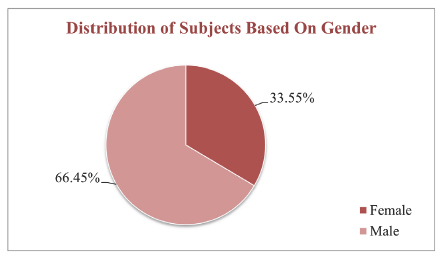
Figure 1:
Distribution of subjects based on gender

Figure 2:
Distribution of subjects based on age group
Health related quality of life assessment: Physical Component Summary (PCS)
Analysis of PCS in the study population using SF-36 revealed the Mean of ‘Health changes’, ‘physical functioning’, ‘pain’’, and ‘ role limitation of physical functioning’ to be 47.43, 58, 45.18, 30.44 respectively Physical functioning dimensions had highest mean and the lowest mean was seen in the role limitation due to physical functioning, as shown in Figure 5.
Mental Component Summary (MCS)
Analysis of mental component summary revealed the mean of social functioning, Role Limitation due to Emotional Problems (RLEP), energy, emotional well-being, to be 52.58, 28.41, 40.41, 40.35 respectively Social functioning had the highest mean i.e., 52.58 and Role Limitation due to Emotional Problems (RLEP) had the lowest mean i.e., 28.41, as shown in Figure 6.
Comparison of quality of life in patients of different age groups: Physical Component Summary (PCS)
On comparing the QOL scores in patients of different age groups, it was found that the patient belonging to the age group ≤20 had lowest mean score for PCS i.e.,39.12. Figure 7 represents the average QOL scores under each PCS domain i.e., Physical Functioning, Role limitation due to physical health, Pain and Health changes within different age groups.
Mental Component Summary (MCS)
On comparing the QOL scores in patients of different age groups, it was found that the patient belonging to the age group ≤20 had lowest mean score for MCS i.e., 38.43. The average QOL scores under each MCS domain i.e., Role limitation due to emotional problems, energy, emotional well-being and social functioning within different age groups has been represented in Figure 8.
Comparison of Gender Differences in Quality-Of-Life Scores: Physical Component Summary (PCS)
In all four domains of the physical component summary i.e., ‘Physical Functioning’, ‘Role limitation due to physical health’, ‘Pain’, and ‘Health changes’, the average QOL scores in males were found to be more than that of females. The average scores of each domain are shown in Figure 9.
Mental Component Summary (MCS)
On comparing the mean scores of Mental component summary between males and females, it was found that males had affected more quality-of-life scores compared to females. The average values of all the four domains of MCS i.e., Role limitation due to emotional problems, energy, emotional well-being and social functioning are shown in Figure 10.
Medication Adherence: Distribution of subjects based on Medication Adherence
Among the 152 patients, 32.24% patients were highly adherent, 39.47% patients were moderately adherent, 28.29% patients were low adherent to their medication as shown in the Figure 11.
Comparison Between Medication Adherence and Quality Of Life in Patients: Physical Component Summary (PCS)
The highest mean score was seen in patients with High adherence i.e., 47.38, as shown in Figure 12. The patients with higher adherence have the good HRQoL as compared to patients with lower adherence.
Mental Component Summary (MCS)
The highest mean score was seen in patients with moderate adherence i.e., 40.47. However, there are not much differences in their means. Figure 13 shows the mean MCS scores in patients with medication adherence.
DISCUSSION
All the required data for this study was collected in a single interview within a mean time span of three months after cardiac surgery. In this study pre-operative evaluation is not done, according to the research conducted by Gomes et al.,10 he stated that pre-operative QoL will be lower than post-operative QoL.

Figure 3:
Personal History

Figure 4:
Prevalence of co-morbidities In Study Population
Patients normally have a concept of thinking that after surgery everything is going to be normal, but it’s noticeable that the therapeutic method can only decrease the sign and symptoms but do not cure them. Coronary artery disease is the most common disorder which is life-threatening in the world. This study gives the overall idea of how health-related quality of life and medication adherence shows an impact in patients after cardiac surgery.11
In this study out of 152 patients, 13% indulged in habits such as Smoking and 14% were Alcoholic and the remaining 37% were non-smokers and 36% were non-alcoholic and in patients the most commonly seen co-morbidity was HTN with 54.60% and the least found co-morbidity was Osteomyelitis with 1% and Typhoid with 1%. Majority of patients in our study of about 54.60 were hypertensive. Contrary to this study conducted by Stana Pacaric et al.12 according to risk factors, 21 (45%) participants were smokers, 35 (75%) had hypertension, 16 (34%) had diabetes, and 29 (61%) had high cholesterol. And also, study conducted by Reeni John, et al.,12 which reveals that majority of their subjects were prone to smoking and alcoholism. Hypertension was found to be the most common comorbid condition with about 56% of patients suffering from it followed by renal diseases with 4.50%. The study by Reeni John et al.,12 also had diabetes as the most common comorbid condition.

Figure 5:
Physical Component Summary (PCS)
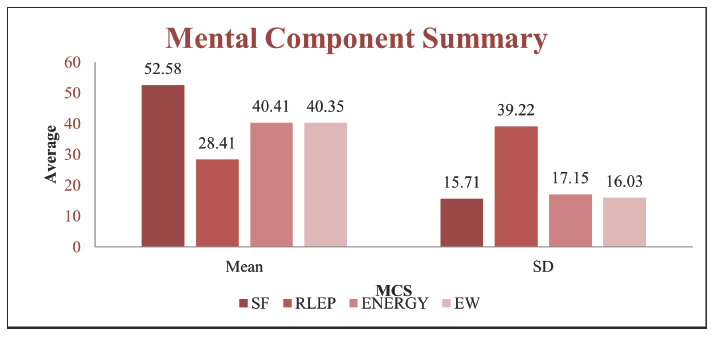
Figure 6:
Mental Component Summary (MCS)
HRQoL was assessed using SF-36 sub-scales scores, according to this study the Mean of Health changes, physical functioning, pain and role limitation of physical functioning to be 47.43, 58, 45.18, 30.44 respectively. Physical functioning dimension had highest mean and the lowest mean was seen in the role limitation due to physical functioning. And that of mental health revealed that the mean of social functioning, Role Limitation due to Emotional Problems (RLEP), energy, emotional well-being, to be 52.58, 28.41, 40.41, 40.35 respectively. Social functioning had the highest mean i.e., 52.58 and Role Limitation due to Emotional Problems (RLEP) had the lowest mean i.e., 28.41. Some of the following similar researches conducted on HRQoL assessment using SF-36 subscales showed following results, by Kurfirst et al.13 in Cardiac Surgery Department of Hospital Ceske Budejovice which showed significantly improvement in all 8 health domains and the mean of physical functioning, role physical, bodily pain, general health, vitality, social functioning, role emotional and mental health was found to be 65.5, 51.1, 73.9, 51.8, 57.4, 73.6, 67.9, 70.6 which showed increased bodily pain and decreased role physical. By Colleen Gorman Koch et al.5 in those who have pre-operative baseline and follow up DASI (Duke Activity Status Index) which resulted in poor HRQoL after recovery from cardiac surgery. Here most patients reported improvement in functional quality of life after surgery. By Moheddine Younsi et al.,14 the average score of Physical functioning, role-physical, bodily pain, general health, social functioning, role-emotional, vitality, mental health were found to be 0.84, 0.53, 0.45, 0.50, 0.35, 0.37, 0.38, 0.34.
Comparison of the QOL scores in both males and females in the study revealed that females had slightly lower scores than males in MCS (role limitation due to emotional health, energy, emotional wellbeing, social functioning) with 21.525±35.020, 42.812±17.407, 38.562±16.231, 51.614±12.347 for females, 30.195±39.64, 38.936±16.645, 39.617±16.011, 53.165±16.32 for males, and there were all statistically significant differences in the QOL among the study subjects based of gender. These findings are consistent with the observations of Gautam et al.,15 where the QOL scores among males were higher in all domains except in general health.
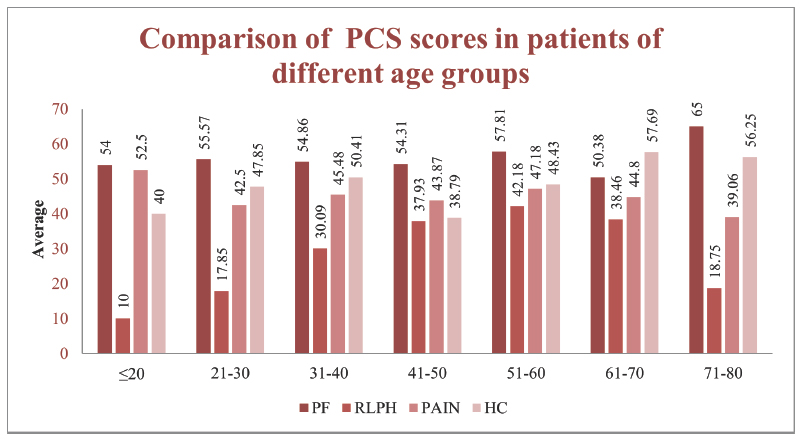
Figure 7:
Physical Component Summary (PCS)
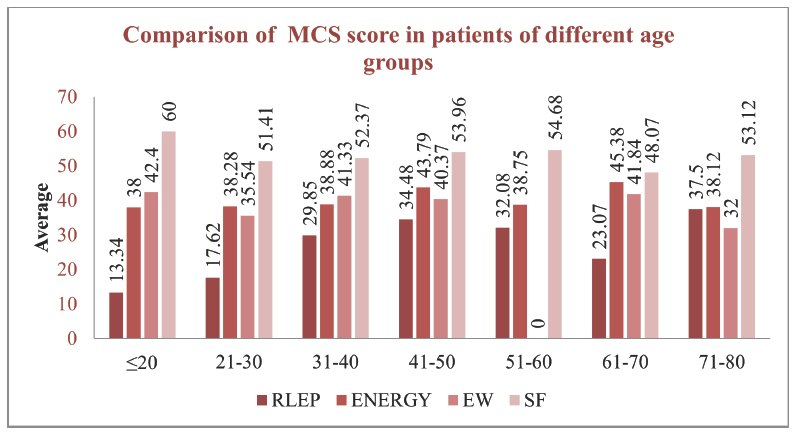
Figure 8:
Mental Component Summary (MCS)
Medication adherence was assess using MMAS-4 questionnaire tool and patients were sub scored as, highly adherent, moderately adherent and low adherent. In this study out of 152 patients, more patients were moderately adherent (39.47%) and patients were low adherent were least (28.29%) to their medication.
When correlating medication adherence with HRQoL, highly and moderately adherent patients to medication were having improved QoL. As a result of non-adherence patients did not get an appropriate benefit from surgical treatment and they showed low QoL. These results are similar to study done by Balasi et al.,11 where belief about medication adherence was good among most of the study patient and beneficially and effectiveness of drugs on quality of life after CABG surgery was promoted.
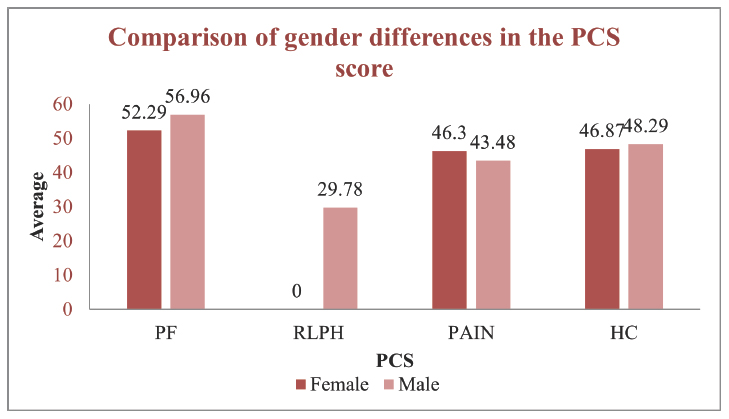
Figure 9:
Physical Component Summary (PCS)
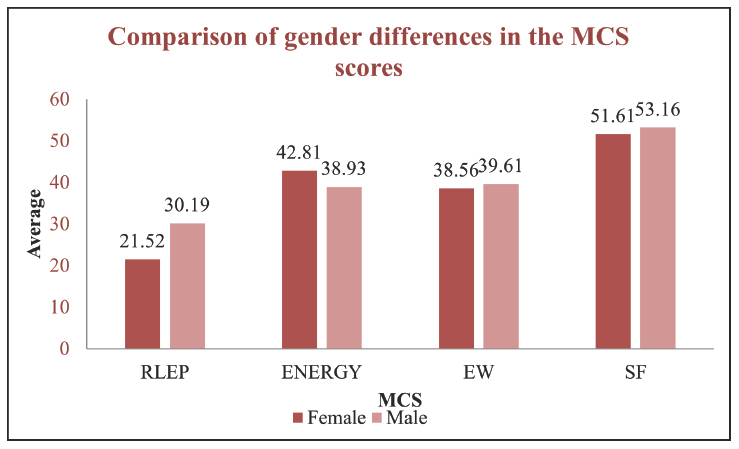
Figure 10:
Mental Component Summary (MCS)
The limited sample size and the fact that the study was conducted at a single location in one geographical area are both limitations of this study. One of the study’s shortcomings is that we lack sufficient data for economic evaluation, which will undoubtedly be the focus of future research. Patients undergoing emergency surgery were omitted from the study because they might not be able to offer reliable information about their health state before to surgery, which could be another research drawback. Patients who were receiving palliative revascularization were omitted from the trial, which might be a restriction since we couldn’t compare quality of life in patients with optimum revascularization to patients who were undergoing palliative revascularization. The findings of our study cannot be applied to the full population of CABG surgery patients in India, but they may be used to develop therapies that would enhance these patients’ quality of life.
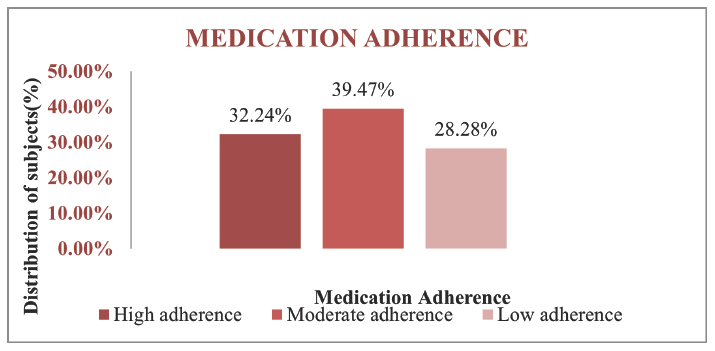
Figure 11:
Distribution of subjects based on Medication Adherence

Figure 12:
Physical Component Summary (PCS)
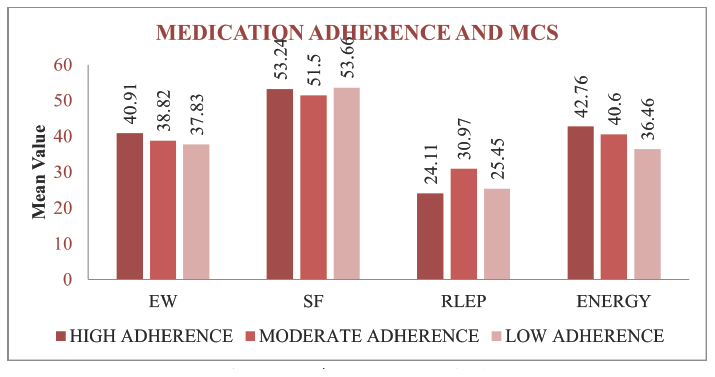
Figure 13:
Mental Component Summary (MCS)
CONCLUSION
According to World Health Organization, India reports one-fifth of these deaths worldwide is especially in younger population. Due to this leading cause many people undergo cardiac surgeries. Our project aims, how the HRQoL and medication adherence plays an important role in post-operative cardiac patients. Low health-related quality of life following cardiac surgery determines which patients have a lower chance of long-term survival. We come to the conclusion that the SF-36 score should be evaluated in order to help determine which patients are most likely to have an improvement in their overall quality of life after cardiac surgery. The study’s findings suggest that clinicians can more easily identify individuals who are likely to achieve post-operative HRQoL improvement. We believe our study could help pave the way for more research that could validate the reliability of our findings in a larger population of cardiac surgery patients, and perhaps generate criteria for identifying people who are likely to improve in HRQoL after cardiac surgery.
Cite this article
Chacko A, Shirol GMN, Mehta P, Nelson CT, Swamy AHMV, Nyamagoud SB. Assessment of Health-Related Quality of Life and Medication Adherence in Post-Operative Cardiac Surgery Patients in a Tertiary Care Hospital. Int. J. Pharm. Investigation. 2023;13(4):895-903.
ACKNOWLEDGEMENT
The authors are thankful to the Vice-Chancellor, Registrar and Dean of Pharmacy, KLE Academy of Higher Education and Research, Belagavi. We would also like to thank medical and hospital staff of Vivekanand General Hospital, Hubballi for providing necessary support.
ABBREVIATIONS
| HRQoL: | Health Related Quality of Life |
|---|---|
| PCS: | Physical Component Summary |
| MCS: | Mental Component Summary |
| MMAS-4: | Morisky Medication Adherence Scale |
| SF-36: | Short Form-36 |
| PF: | Physical Functioning |
| RLPH: | Role Limitation due to Physical Health |
| RLEP: | Role Limitation due to Emotional Problems |
| EW: | Emotional Well-being |
| SF: | Social Functioning |
References
- Pačarić S, Turk T, Erić I, Erić A, Milostić-Srb A. Assessment of the quality of life in patients before and after Coronary Artery Bypass Grafting (CABG): A prospective study. Int J Environ Res Public Health. 2020;2020(4):1417 [PubMed] | [CrossRef] | [Google Scholar]

- Cardiovascular diseases [internet]. [[cited Jul 7 2023]]. Available from: https://www.who.int/india/health-topics/cardiovascular-diseases

- Colak Z, Segotic I, Uzun S, Mazar M, Ivancan V, Majeric-Kogler V, et al. Health related quality of life following cardiac surgery — correlation with EuroSCORE. Eur J Cardiothorac Surg. 2008;2008(1):72-6. [PubMed] | [CrossRef] | [Google Scholar]

- Grazulyte D, Norkiene I, Kazlauskas E, Truskauskaite-Kuneviciene I, Kolevinskaite S, Ringaitiene D, et al. Predictors of long-term HRQoL following cardiac surgery: A 5-year follow-up study. Health Qual Life Outcomes. 2021;2021(1):197 [PubMed] | [CrossRef] | [Google Scholar]

- Koch CG, Li L, Lauer M, Sabik J, Starr NJ, Blackstone EH, et al. Effect of functional health-related quality of life on long-term survival after cardiac surgery. Circulation. 2007;2007(6):692-9. [PubMed] | [CrossRef] | [Google Scholar]

- Ali MA, Yasir J, Sherwani RN, Fareed M, Arshad F, Abid F, et al. Frequency and predictors of non-adherence to lifestyle modifications and medications after coronary artery bypass grafting: A cross-sectional study. Indian Heart J. 2017;2017(4):469-73. [PubMed] | [CrossRef] | [Google Scholar]

- Tackmann E, Dettmer S. Health-related quality of life in adult heart-transplant recipients—a systematic review. Herz. 2020;2020(5):475-82. [PubMed] | [CrossRef] | [Google Scholar]

- Brocks Y, Zittermann A, Grisse D, Schmid-Ott G, Stock-GieBendanner S, Schulz U, et al. Adherence of heart transplant recipients to prescribed medication and recommended lifestyle habits. Prog Transplant. 2017;2017(2):160-6. [PubMed] | [CrossRef] | [Google Scholar]

- Rumsfeld JS, MaWhinney S, McCarthy M, Shroyer AL, VillaNueva CB, O’Brien M, et al. Health-related quality of life as a predictor of mortality following coronary artery bypass graft surgery. Participants of the Department of Veterans Affairs Cooperative Study Group on Processes, Structures, and Outcomes of Care in Cardiac Surgery JAMA. 1999;1999(14):1298-303. [PubMed] | [CrossRef] | [Google Scholar]

- Gomes T, Gomes L, Antônio I, Barroso T, Cavalcante A, Stival M, et al. Avaliação da qualidade de vidapós-implante de marcapassocardíaco artificial. Rev Eletrônica Enferm. 2011;2011(4):735-42. [PubMed] | [CrossRef] | [Google Scholar]

- Balasi L, Paryad E, Booraki SH, Leili E, Meibodi AM, Sheikhani N, et al. Medication adherence after CABG and its related to medication belief. Biomed Pharmacol J. 2015;2015(2):603-10. [CrossRef] | [Google Scholar]

- John R, Pise S, Chaudhari L, Deshpande PR. Evaluation of quality of life in type 2 diabetes mellitus patients using quality of life instrument for Indian diabetic patients: A cross-sectional study. J Mid Life Health. 2019;2019(2):81-8. [PubMed] | [CrossRef] | [Google Scholar]

- Kurfirst V, Mokráček A, Krupauerová M, Čanádyová J, Bulava A, Pešl L, et al. Health-related quality of life after cardiac surgery – the effects of age, preoperative conditions and postoperative complications. J Cardiothorac Surg. 2014;2014(1):46 [PubMed] | [CrossRef] | [Google Scholar]

- Younsi M. Health-related quality-of-life measures: evidence from Tunisian population using the SF-12 Health Survey. Value Health Reg Issues. 2015;7:54-66. [PubMed] | [CrossRef] | [Google Scholar]

- Gautam Y, Sharma A, Agarwal A, Bhatnagar M, Trehan RR. A cross-sectional study of QOL of diabetic patients at tertiary care hospitals in Delhi. Indian J Community Med. 2009;2009(4):346-50. [PubMed] | [CrossRef] | [Google Scholar]


